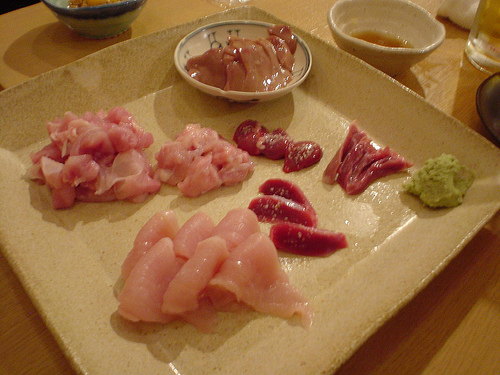Eating Raw Chicken
If you plan to serve a chicken dinner over the holidays, save yourself some time and serve it raw. Call it Chicken Sashimi, which is a Japanese delicacy, and is basically raw chicken. (image via geoffmackay.com)

According to a writer in Esquire, raw chicken isn't actually more dangerous than any other raw meat:
Next time you order chicken at a restaurant, ask for it medium rare and see how the waiter reacts.

According to a writer in Esquire, raw chicken isn't actually more dangerous than any other raw meat:
One of the first things any novice cook is taught is that when working with chicken, we must blast it with heat to lay waste to every last microbe. We cure pork and call it ham, order duck breast medium-rare, savor lamb chops served blue, but we won't serve an Oven Stuffer Roaster whose juices aren't running clear. I thought that maybe pink chicken might not only taste better but eliminate an item from my list of things to fear while cooking.
But first, there was the small matter of salmonella. I spoke with a number of poultry scientists and discovered that while it's plausible that salmonella (a bacterium that, by the way, is hardly unique to chickens) could show up on a chicken's skin and contaminate cutting boards, the chances that it works its way inside a muscle, like the breast, all by itself? Very, very slim, and really no different from the odds of E. coli camping out in a medium-rare steak. The Centers for Disease Control has documented five salmonella outbreaks this year, none of which involved eating chicken.
To be clear: ingesting almost anything involves a certain level of risk. But if you've ever eaten supermarket cold cuts, potato salad at a steamy August cookout, or any food while vacationing in Mexico, pink chicken should rest squarely within your food-safety comfort zone.
But first, there was the small matter of salmonella. I spoke with a number of poultry scientists and discovered that while it's plausible that salmonella (a bacterium that, by the way, is hardly unique to chickens) could show up on a chicken's skin and contaminate cutting boards, the chances that it works its way inside a muscle, like the breast, all by itself? Very, very slim, and really no different from the odds of E. coli camping out in a medium-rare steak. The Centers for Disease Control has documented five salmonella outbreaks this year, none of which involved eating chicken.
To be clear: ingesting almost anything involves a certain level of risk. But if you've ever eaten supermarket cold cuts, potato salad at a steamy August cookout, or any food while vacationing in Mexico, pink chicken should rest squarely within your food-safety comfort zone.
Next time you order chicken at a restaurant, ask for it medium rare and see how the waiter reacts.
Comments
Have you ever seen what a chicken eats?
No worries.... no chickens on board anyhow.
No worries.... no chickens on board anyhow.
Posted by Expat47 in Athens, Greece on 12/22/12 at 11:24 AM
Disgusting! No way in the world I'd eat raw chicken! (or beef, almost didn't try sushi either)
Posted by Patty in Ohio, USA on 12/23/12 at 10:46 PM
I took a college biology course from a parasitologist. E. coli and salmonella are tame compared to the OTHER things that could be living in your food.
Posted by tadchem on 10/20/13 at 10:28 AM
Commenting is not available in this channel entry.

Category: Food